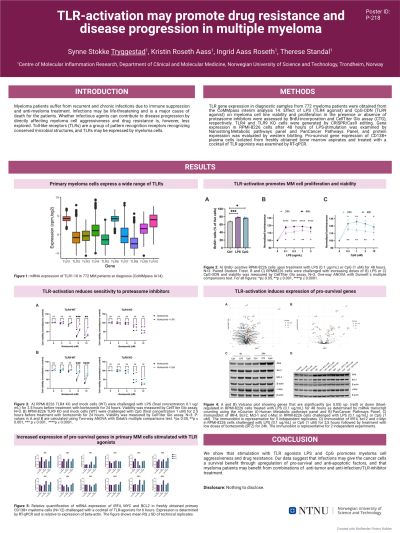Myeloma Novel Drug Targets and agents
Poster Session 2
P-218: TLR-activation may promote drug resistance and disease progression in multiple myeloma
Thursday, September 28, 2023
12:30 PM - 1:30 PM EEST


Synne S. Tryggestad, MS (she/her/hers)
PhD Candidate
NTNU
Trondheim, Sor-Trondelag, Norway
Introduction: Myeloma patients suffer from recurrent and chronic infections due to immune suppression and anti-myeloma treatment. Infections may be life threatening and is a major cause of death for the patients. Whether infectious agents can contribute to disease progression by directly affecting myeloma cell aggressiveness and drug resistance is, however, less explored. Toll-like receptors (TLRs) are a group of pattern recognition receptors recognizing conserved microbial structures, and TLRs may be expressed by myeloma cells.
Methods: We analyzed TLR gene expression in samples from 772 myeloma patients (CoMMpass IA14). In vitro, we challenged the myeloma cell line RPMI-8226 with TLR4 agonist LPS and TLR9 agonist CpG, and assessed the effect on cell viability and proliferation, as well as expression of a range of pro-survival and anti-apoptotic factors. Lastly, we assessed the effect of TLR-activation on MM cell drug sensitivity towards proteasome inhibitors bortezomib and carfilzomib.
Results: We show that primary myeloma cells expressed a broad range of TLRs, and TLR4 and TLR9 were among the most highly expressed receptors. When we challenged the myeloma cell line RPMI-8226 with TLR4 agonist LPS and TLR9 agonist CpG, both cell viability and proliferation was increased. TLR-stimulation did also upregulate protein expression of a range of well-known pro-survival and anti-apoptotic factors in myeloma, including c-Myc, IRF4, Mcl-1 and Bcl-2. Further, when we treated RPMI-8226 cells with a combination of TLR agonists and proteasome inhibitors bortezomib and carfilzomib, the cells' drug sensitivity was reduced. The reduction in drug sensitivity is mediated by TLR-signaling, since the protective effect of TLR-stimulation was lost in cells depleted for TLR4 and TLR9.
Conclusions: We show that stimulation with TLR agonists LPS and CpG promotes myeloma cell aggressiveness and drug resistance. Our data suggest that infections may give the cancer cells a survival benefit through upregulation of pro-survival and anti-apoptotic factors, and that myeloma patients may benefit from combinations of anti-tumor and anti-infection/TLR-inhibitor treatment.
Methods: We analyzed TLR gene expression in samples from 772 myeloma patients (CoMMpass IA14). In vitro, we challenged the myeloma cell line RPMI-8226 with TLR4 agonist LPS and TLR9 agonist CpG, and assessed the effect on cell viability and proliferation, as well as expression of a range of pro-survival and anti-apoptotic factors. Lastly, we assessed the effect of TLR-activation on MM cell drug sensitivity towards proteasome inhibitors bortezomib and carfilzomib.
Results: We show that primary myeloma cells expressed a broad range of TLRs, and TLR4 and TLR9 were among the most highly expressed receptors. When we challenged the myeloma cell line RPMI-8226 with TLR4 agonist LPS and TLR9 agonist CpG, both cell viability and proliferation was increased. TLR-stimulation did also upregulate protein expression of a range of well-known pro-survival and anti-apoptotic factors in myeloma, including c-Myc, IRF4, Mcl-1 and Bcl-2. Further, when we treated RPMI-8226 cells with a combination of TLR agonists and proteasome inhibitors bortezomib and carfilzomib, the cells' drug sensitivity was reduced. The reduction in drug sensitivity is mediated by TLR-signaling, since the protective effect of TLR-stimulation was lost in cells depleted for TLR4 and TLR9.
Conclusions: We show that stimulation with TLR agonists LPS and CpG promotes myeloma cell aggressiveness and drug resistance. Our data suggest that infections may give the cancer cells a survival benefit through upregulation of pro-survival and anti-apoptotic factors, and that myeloma patients may benefit from combinations of anti-tumor and anti-infection/TLR-inhibitor treatment.
